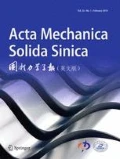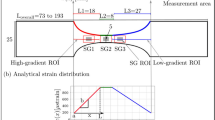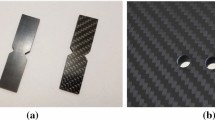Abstract
The stress intensity factor (SIF) at the V-notch tip of a single-edge-notched polymethyl methacrylate plate was measured by the digital gradient sensing (DGS) method. First, the displacement fields near the V-notch tip of the specimen were recorded using digital image correlation under three-point bending. Second, the stress gradient function of the V-notch tip with unknown SIF was deduced from the Williams series expansion for singular elastic stress fields. Finally, the relationship between the stress gradient and the angular deflection around the V-notch tip was established according to the photoelastic effect. Combined with the theory of linear elastic fracture mechanics, it was derived that the angular deflection of each point can be expressed with the unknown SIF. Considering the unavoidable effects of rigid-body translation and rotation in the experiments, the new angular deflection control equation was derived based on the traditional angular deflection control equation. The SIF was obtained by the least square method. The experimental values calculated by the new control equation were compared with the analytical values. The result shows that the DGS method can accurately measure the SIF at the V-notch tip, which effectively improves the accuracy of SIF.














Similar content being viewed by others
References
Nui LS, Chehimi C, Pluvinage G. Stress field near a large blunted tip V-notch and application of the concept of the critical notch stress intensity factor (NSIF) to the fracture toughness of very brittle materials[J]. Eng Fract Mech. 1994;49(3):325–35.
Zappalorto M, Lazzarin P. Strain energy-based evaluations of plastic notch stress intensity factors at pointed V-notches under tension. Eng Fract Mech. 2011;78:2691–706.
Meneghetti G, Guzzella C. The peak stress method to estimate the mode I notch stress intensity factor in welded joints using three-dimensional finite element models. Eng Fract Mech. 2014;115(1):154–71.
Graff S, Forest S, Strudel J, Prioul C, Pilvin P, Béchade J. Finite element simulations of dynamic strain ageing effects at V-notches and crack tips. Scripta Mater. 2005;52:1181–6.
Yao XF, Yeh HY, Xu W. Fracture investigation at V-notch tip using coherent gradient sensing (CGS). Int J Solids Struct. 2006;43:1189–200.
Prassianakis JN. Stress intensity factors at V-notched elastic, symmetrically loaded, plates by the method of caustics. J Phys D Appl Phys. 1980;13(6):1043.
Xu W, Xu W, Yeh HY, Jin GC. Fracture investigation of PMMA specimen using coherent gradient sensing (CGS) technology. Polym Exp. 2005;24:900–8.
Xu W, Yao XF, Xu MQ, et al. Fracture characterizations of V-notch tip in PMMA polymer material. Polym Exp. 2004;23(5):509–15.
Yadegari Dehnavi MR, Eshraghi I, Soltani N. Investigation of fracture parameters of edge V-notches in a polymer material using digital image correlation. Polym Exp. 2013;32:778–84.
Periasamy C, Tippur HV. A full-field digital gradient sensing method for evaluating stress gradients in transparent solids. Appl Opt. 2012;51(12):2088–97.
Zhang R, Guo R, Wang S. Mixed mode fracture study of PMMA using digital gradient sensing method. Eng Fract Mech. 2014;119(3):164–72.
Zhang R, Guo R, Cheng H. Combing DGS and finite element for stress analysis using inverse boundary method. Appl Opt. 2014;53(35):8350–7.
Zhang R. Evaluating angular deflections from the digital gradient sensing method with rigid-motion deleted. Meas Sci Technol. 2016;27(6):065202.
Yuan Y, Hao W, Ma Y. Stress field at V-notch tip in polymer materials using digital gradient sensing. Mech Compos Mater Struct. 2017;24(4):350–6.
Periasamy C, Tippur HV. Measurement of crack-tip and punch-tip transient deformations and stress intensity factors using digital gradient sensing technique. Eng Fract Mech. 2013;98(1):185–99.
Pan B, Xie H, Wang Z, et al. Study on subset size selection in digital image correlation for speckle patterns. Opt Express. 2008;16(10):7037–48.
Zhao Z, Hahn HG. Determining the SIF of a V-notch from the results of a mixed-mode crack. Eng Fract Mech. 1992;43(4):511–8.
Acknowledgements
The work is supported by the National Basic Research Program of China (under Grant No. 14118683); China Postdoctoral Science Foundation (under Grant No. 2014M552548XB); and the National Natural Science Foundation of China (under Grant No. 11402103).
Author information
Authors and Affiliations
Corresponding author
Rights and permissions
About this article
Cite this article
Chen, D., Zhang, R. & Guo, R. Studying V-Notch Stress Intensity Factor by Digital Gradient Sensing Method. Acta Mech. Solida Sin. 32, 378–392 (2019). https://doi.org/10.1007/s10338-019-00082-x
Received:
Revised:
Accepted:
Published:
Issue Date:
DOI: https://doi.org/10.1007/s10338-019-00082-x




